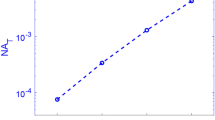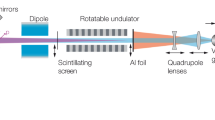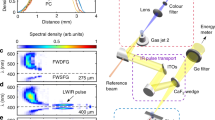Abstract
Plasma channels produced in air through femtosecond laser filamentation1,2,3,4 hold great promise for a number of applications, including remote sensing5, attosecond physics6,7 and spectroscopy8, channelling microwaves9,10,11,12 and lightning protection13. In such settings, extended filaments are desirable, yet their longitudinal span is limited by dissipative processes. Although various techniques aiming to prolong this process have been explored, the substantial extension of optical filaments remains a challenge14,15,16,17,18,19,20,21. Here, we experimentally demonstrate that the natural range of a plasma column can be enhanced by at least an order of magnitude when the filament is prudently accompanied by an auxiliary beam. In this arrangement, the secondary low-intensity ‘dressing’ beam propagates linearly and acts as a distributed energy reservoir22, continuously refuelling the optical filament. Our approach offers an efficient and viable route towards the generation of extended light strings in air without inducing premature wave collapse or an undesirable beam break-up into multiple filaments2.
This is a preview of subscription content, access via your institution
Access options
Subscribe to this journal
Receive 12 print issues and online access
$209.00 per year
only $17.42 per issue
Buy this article
- Purchase on Springer Link
- Instant access to full article PDF
Prices may be subject to local taxes which are calculated during checkout




Similar content being viewed by others
References
Braun, A. et al. Self-channeling of high-peak-power femtosecond laser pulses in air. Opt. Lett. 20, 73–75 (1995).
Couairon, A. & Mysyrowicz, A. Femtosecond filamentation in transparent media. Phys. Rep. 441, 47–189 (2007).
Berge, L. Wave collapse in physics: principles and applications to light and plasma waves. Phys. Rep. 303, 259–370 (1998).
Mlejnek, M., Wright, E. M. & Moloney, J. V. Dynamic spatial replenishment of femtosecond pulses propagating in air. Opt. Lett. 23, 382–384 (1998).
Luo, Q. et al. Remote sensing of pollutants using femtosecond laser pulse fluorescence spectroscopy. Appl. Phys. B 82, 105–109 (2006).
Stibenz, G., Zhavoronkov, N. & Steinmeyer, G. Self-compression of millijoule pulses to 7.8 fs duration in a white-light filament. Opt. Lett. 31, 274–276 (2006).
Popmintchev, T. et al. Bright coherent ultrahigh harmonics in the keV X-ray regime from mid-infrared femtosecond lasers. Science 336, 1287–1291 (2012).
Singh, J. P. & Thakur, S. N. Laser Induced Breakdown Spectroscopy (Elsevier, 2007).
Chateauneuf, M., Payeur, S., Dubois, J. & Kieffer, J. C. Microwave guiding in air by a cylindrical filament array waveguide. Appl. Phys. Lett. 92, 091104 (2008).
Marian, A. et al. The interaction of polarized microwaves with planar arrays of femtosecond laser-produced plasma filaments in air. Phys. Plasmas 20, 023301 (2013).
Alshershby, M., Hao, Z. & Lin, J. Hollow cylindrical plasma filament waveguide with discontinuous finite thickness cladding. Phys. Plasmas 20, 013501 (2013).
Ren, Y., Alshershby, M., Qin, J., Hao, Z. & Lin, J. Microwave guiding in air along single femtosecond laser filament. J. Appl. Phys. 113, 094904 (2013).
Kasparian, J. et al. Electric events synchronized with laser filaments in thunderclouds. Opt. Express 16, 5757–5763 (2008).
Tzortzakis, S. et al. Concatenation of plasma filaments created in air by femtosecond infrared laser pulses. Appl. Phys. B 76, 609–612 (2003).
Cai, H., Wu, J., Li, H., Bai, X. & Zeng, H. Elongation of femtosecond filament by molecular alignment in air. Opt. Express 17, 21060–21065 (2009).
Wang, H., Fan, C., Zhang, P., Zhang, J. & Qiao, C. Extending mechanism of femtosecond filamentation by double coaxial beams. Opt. Commun. 305, 48–52 (2013).
Polynkin, P. et al. Generation of extended plasma channels in air using femtosecond Bessel beams. Opt. Express 16, 15733–15740 (2008).
Fu, Y. et al. Generation of extended filaments of femtosecond pulses in air by use of a single-step phase plate. Opt. Lett. 34, 3752–3754 (2009).
Sun, X. et al. Multiple filamentation generated by focusing femtosecond laser with axicon. Opt. Lett. 37, 857–859 (2012).
Kosareva, O. G., Grigor'evskii, A. V. & Kandidov, V. P. Formation of extended plasma channels in a condensed medium upon axicon focusing of a femtosecond laser pulse. Quantum Electron. 35, 1013–1014 (2005).
Akturk, S. et al. Generation of long plasma channels in air by focusing ultrashort laser pulses with an axicon. Opt. Commun. 282, 129–134 (2009).
Mills, M. S., Kolesik, M. & Christodoulides, D. N. Dressed optical filaments. Opt. Lett. 38, 25–27 (2013).
Wood, W. M., Siders, C. W. & Downer, M. C. Measurement of femtosecond ionization dynamics of atmospheric density gases by spectral blueshifting. Phys. Rev. Lett. 67, 3523–3526 (1991).
Wu, J., Cai, H., Zeng, H. & Couairon, A. Femtosecond filamentation and pulse compression in the wake of molecular alignment. Opt. Lett. 33, 2593–2595 (2008).
Yang, X. et al. Noncollinear interaction of femtosecond filaments with enhanced third harmonic generation in air. Appl. Phys. Lett. 95, 111103 (2009).
Skupin, S., Stibenz, G. & Bergé, L. Self-compression by femtosecond pulse filamentation: experiments versus numerical simulations. Phys. Rev. E 74, 056604 (2006).
Xi, T. T., Lu, X. & Zhang, J. Interaction of light filaments generated by femtosecond laser pulses in air. Phys. Rev. Lett. 96, 025003 (2006).
Liu, W. et al. Experiment and simulations on the energy reservoir effect in femtosecond light filaments. Opt. Lett. 30, 2602–2604 (2005).
Mlejnek, M., Kolesik, M. & Moloney, J. V. & Wright, E. M. Optically turbulent femtosecond light guide in air. Phys. Rev. Lett. 83, 2938–2941 (1999).
Kolesik, M. & Moloney, J. V. Nonlinear optical pulse propagation simulation: From Maxwell's to unidirectional equations. Phys. Rev. E 70, 036604 (2004).
Clerici, M. et al. Finite-energy, accelerating Bessel pulses. Opt. Express 16, 19807–19811 (2008).
Abdollahpour, D., Suntsov, S., Papazoglou, D. G. & Tzortzakis, S. Measuring easily electron plasma densities in gases produced by ultrashort lasers and filaments. Opt. Express 19, 16866–16871 (2011).
Acknowledgements
This work was supported by the Air Force Office of Scientific Research (AFOSR; grants FA9550-10-1-056 and FA9550-12-1-0143) and the Defense Threat Reduction Agency (DTRA; grant HDTRA 1-14-1-0009).
Author information
Authors and Affiliations
Contributions
M.S.M., M.K. and D.N.C. suggested the idea of dressed filaments. M.S.M., M.-A.M. and D.N.C. produced the manuscript, figures and accompanying Supplementary Information. M.S.M. explored the theoretical aspects of the paper and simulated the process using M.K.'s code. M.S., W.C., J.V.M. and P.P. carried out the experiments reported in this study.
Corresponding author
Ethics declarations
Competing interests
The authors declare no competing financial interests.
Supplementary information
Supplementary information
Supplementary information (PDF 1363 kb)
Rights and permissions
About this article
Cite this article
Scheller, M., Mills, M., Miri, MA. et al. Externally refuelled optical filaments. Nature Photon 8, 297–301 (2014). https://doi.org/10.1038/nphoton.2014.47
Received:
Accepted:
Published:
Issue Date:
DOI: https://doi.org/10.1038/nphoton.2014.47
This article is cited by
-
Long distance laser filamentation using Yb:YAG kHz laser
Scientific Reports (2023)
-
Energy transmittance of focused femtosecond pulses at different air pressures
Optoelectronics Letters (2023)
-
Frontiers in multidimensional self-trapping of nonlinear fields and matter
Nature Reviews Physics (2019)
-
Towards Remote Lightning Manipulation by Meters-long Plasma Channels Generated by Ultra-Short-Pulse High-Intensity Lasers
Scientific Reports (2019)
-
Terahertz wave generation from ring-Airy beam induced plasmas and remote detection by terahertz-radiationenhanced- emission-of-fluorescence: a review
Frontiers of Optoelectronics (2019)



